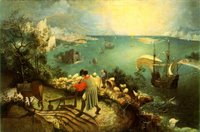A few years later, my sister and I flew to Europe for the first time, traveling with one great-uncle to visit another. We spent a day at the museum in the poem, the Musée Royaux des Beaux-Arts, in Brussels. The Institution, my great uncles call it, as it was there that my great-aunt spent her career as an art historian, studying and writing about the Early Flemish Primitives. It was there too that I found Icarus, falling from the sky.
 After so much anticipation, actually seeing the painting was a disappointment. It was much smaller than I imagined and guarded by heavy glass that reflected the ceiling lights so badly you had to approach it from the side, not straight on. I replaced my grimy photocopy with a postcard. I could just make out Icarus‘ legs kicking as they disappeared into the sea. The color was beautiful.
After so much anticipation, actually seeing the painting was a disappointment. It was much smaller than I imagined and guarded by heavy glass that reflected the ceiling lights so badly you had to approach it from the side, not straight on. I replaced my grimy photocopy with a postcard. I could just make out Icarus‘ legs kicking as they disappeared into the sea. The color was beautiful.When we first moved to Prague, we planned a trip to Vienna to visit the Kunsthistorische Muzeum. My great-uncle, who likes Bruegel even more than I do, gave me a lecture about the Kunsthistorische Bruegels before we left on our trip. “At least find the Children’s Games, Massacre of the Innocents and the three season paintings,“ he said. “Buy calendars.“ I knew what he meant. Art calendars come sturdily wrapped, with bigger pictures than in a book or on a postcard, and 12 images for almost the price of one poster. And because they are European style, the dates are so small you can easily ignore them when your year is up. It is a great way to gather a favorite artist's works all in once place, big enough to really see the detail, and without a binding to worry about either.
I bought calendars. And this time thought the Bruegels in their musuem setting gorgeous. I especially loved Bruegel's winter scene - Hunters in the Snow - with its flat, almost asian style, the contrast between the snow and the sky and ice, the cheerful curl of the dog tails.

If you do a Google search on Bruegel and his six seasonal paintings, you’ll see that three of the six are in Vienna, one hangs in the Metropolitan, and one is missing. That is five. The sixth is in the Czech Republic. It lives in a chateau outside of Prague, north towards Dresden.* The chateau (or zamek in Czech) is called Nelahozeves and it is just along the Vltava river, in a small town of the same name - incidentally the same town Antonin Dvorak lived in most of his life, just below the chateau walls.
The chateau is owned by the Roudnice branch of the Lobkowicz family and by itself is a fine place to visit, especially if you like Renaissance architecture. But what makes it different from the hundreds of castles in the Czech Republic is its collection of art and musical instruments. It is the largest private art collection in the Czech Republic, art once scattered across many properties owned by the Lobkowiczs but now gathered together under one roof. The collection includes a Rubens and a Velasquez, and some quite excellent and interesting portraits (Hapsburg family members can mostly not be called beautiful). What really stands out as the jewel of the show, though, is decidedly the Bruegel.
It is a big painting, covering nearly the span of one wall, and the details are what makes it nifty to visit. While I still prefer Hunters in the Snow for its colors and its design, there are more people to get a good glimpse of in Haymaking, and each is doing something a little different from his neighbor. Then too, it's summertime and everyone, even at work, seems more relaxed than in the winter painting. Standing in front of the painting, in its stone room in Nela, I let the design give me a tour, following the characters down the lane, through the broken line of the houses to the hill in the very far distance. Then our real tour guide called us into the next room. I bought a postcard, the colors are beautiful. But I'm looking forward to going to back soon so I can revisit the original.
* The Bruegel, and most of the paintings formally housed in Nela, have since been moved to the Lobkowicz palace next to the castle.

(photo copyright to each painting's museum)


4 comments:
Ah, you too are a Bruegel person. I should have guessed. (I grew up with my father collecting reproductions of "winter scenes" and did a paper on the season paintings a few years ago. I did contemplate putting up a Bruegel Temptation of St. Anthony!)
Interesting to know that the Czech season painting belongs to the Lobkowiczes. I had been under the impression that the Národní galerie had it, so was not sure why it wasn't on display there. I know, however, that the Lobkowiczes have been able to get many of their treasures restituted.
Thanks for humoring my delurk - I love the Bruegels, too. For some reason the shoes fascinate me.
I like the shoes too - especially in the winter scene where they curl up like the dog tails!
Wonderful post. I too like the winter picture...we studied that recently. Hopefully we can visit!
Post a Comment